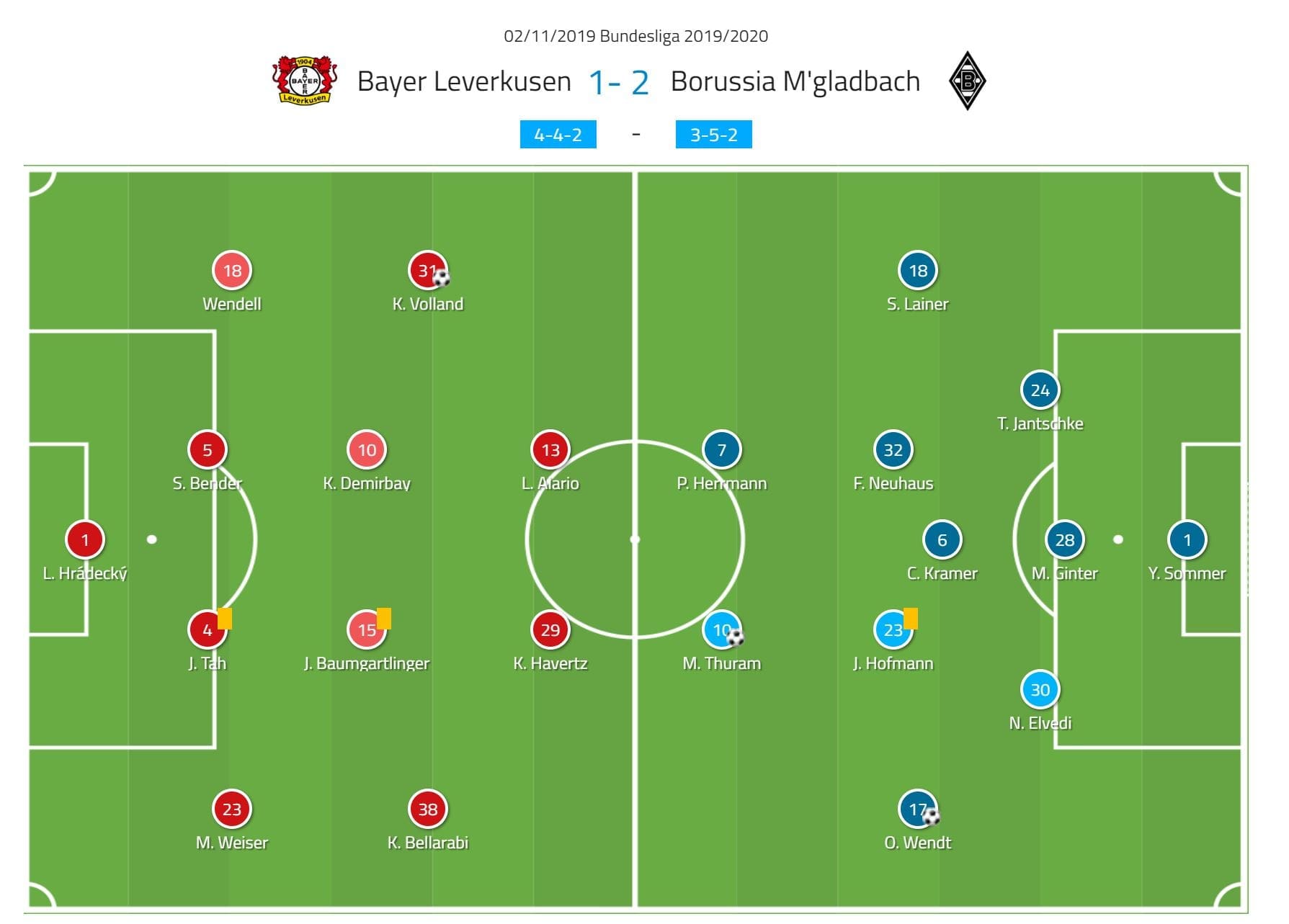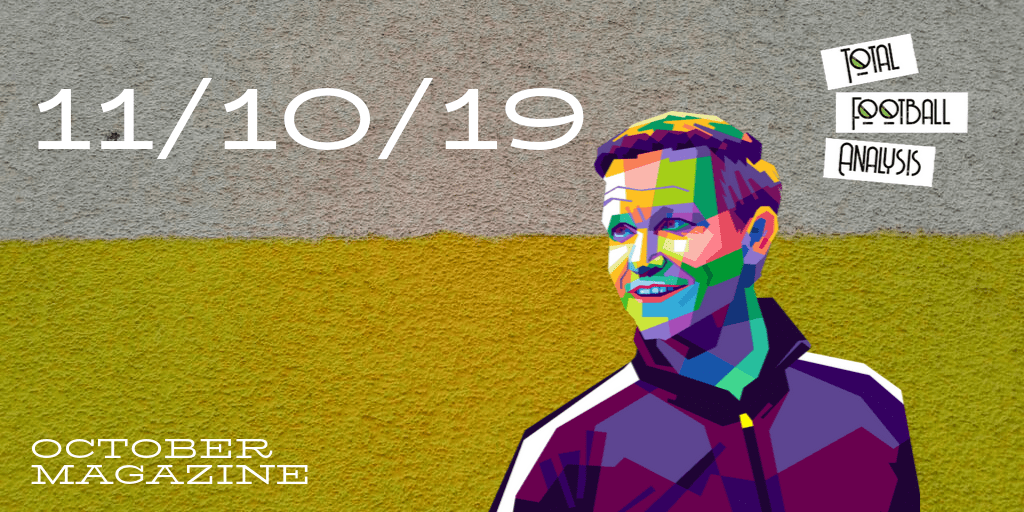This weekend saw a game many had been looking forward to from a tactical perspective, finally arrive in the Bundesliga. Peter Bosz’s possession-dominant Bayer Leverkusen side took on Marco Rose’s famed out-of-possession specialists Borussia Monchengladbach, with an interesting tactical battle sure to ensue. The game offered many familiar tactics from the two sides, but also saw some changes made, particularly from Gladbach’s point of view which were effective in limiting Leverkusen’s threat. In this tactical analysis, I’ll look at how Gladbach were able to carry out an efficient game plan, examine this game plan’s effect on Leverkusen, and also take a look at what went wrong for Leverkusen.
Lineups
Leverkusen took on their usual approach – looking to dominate possession and break down a stubborn defence. They used a 4-4-2 formation generally, but in possession, this resembled more of a 2-4-4, as I will get onto later in this analysis. Gladbach meanwhile went for a different approach, playing three at the back in possession but surprisingly sticking to a four out of possession, with their formation usually resembling a 4-4-2 or a 4-5-1.

Gladbach build-up issues
Gladbach’s switch of formation while in possession caused some issues in their build-up, with Leverkusen’s press helping to make their play predictable. With the dropping midfielders usually covered, Gladbach were left to build with essentially their back five initially. This meant there was a high reliance on playing out through the full-backs, and although they exploited one space a few times, they ultimately struggled.
We can see below Gladbach looked to play down the line in order to progress up the pitch, with central options either ignored or marked. However, it is difficult for either full-back to control the ball and pick out a pass, especially while being pressed in a wide area.

From these wide areas, the full-backs looked to play the ball into the half-space, where Marcus Thuram would often drop in order to progress the ball. Each move relied on short, quick, first time passes, and so Gladbach at times struggled to exploit this space effectively.

We can see here below, with Stefan Lainer marked tightly, Tony Jantschke ignores the central option and instead looks to get the ball into the half-space for Thuram to collect the ball. The problem then became how Gladbach could retain possession and build while the team so deep.

Gladbach punish a Leverkusen weakness, twice.
The story of the game was really the same mistake executed twice by Leverkusen, which we can see below.
Gladbach more or less scored the same goal twice, so let’s look at Leverkusen’s defending in both situations. Marcus Thuram breaks the ankles of the defender and looks to deliver a cross in, and though Leverkusen have players back, they’re unable to provide any real cover, as this next image shows.

Although the first image indicates the cover is there, there’s no pressure put on Thuram and no urgency to stop the cross from Leverkusen, particularly from the midfielder. They could maybe be forgiven for not applying pressure to the ball if they were focusing on their structure to defend the cross, but Bender doesn’t stop the ball being played along the six-yard box, and no players follow the run of Oscar Wendt. Bender instead should have focused on not allowing that cross on the goal side of him – if the opposition pulls it back, they can try and get a block in, but that ball can’t go past Bender. Credit to Marcus Thuram should also be given for an excellent pass, though.

In Gladbach’s second goal, the same occurs. Again they are able to get the ball out wide and play into the half-space, and Leverkusen look like they are able to apply some pressure to the ball. With the pass coming across the player receiving in the half-space, Bender should have time to read the pass and make some ground up to the attacker while the ball is still coming across him.

Again though, Leverkusen don’t apply any pressure on the ball from the front, and Bender stays in position looking to stop the cross. Yet again, he becomes preoccupied in trying to stop the cut back, and allows the ball goal-side of him where Thuram can tap home. Jonathan Tah doesn’t do a great job either in stopping the crossing, as he stood static while Thuram moves in behind him.

Gladbach’s defensive structure
When the lineups came out, most would have assumed Gladbach were lining up a back five out of possession, but Gladbach instead stuck to a narrow 4-4-2 or 4-5-1 at times. This looked to limit Leverkusen’s play in the central areas and stop them from progressing through with clever positional play. In the image below we can see Ginter covering the inside pass while Wendt presses, with the rest of the midfield recovering back.

We can see how compact Gladbach are here within a 4-4-2, with the only options available to them out wide where they were pressed by the full-backs. Late in the second half, Ginter did drop back into defence with Denis Zakaria coming on to play in midfield.

Leverkusen’s lack of awareness
Leverkusen did create some chances, but could have created so much more had their awareness of space and pass selection been better, as we will see in the examples below.
This first example simply shows poor technique, with Leverkusen playing a good penetrative pass through Gladbach’s midfield. Volland drops to receive it, but doesn’t scan once while in this space and therefore doesn’t recognise the space he is in and doesn’t receive the ball on his back foot, which allows Gladbach to recover.

Here, Leverkusen have the chance to play the ball inside, but Bellarabi keeps his head down and doesn’t see the space his teammate is in. Leverkusen at times became impatient and looked to just hit the player furthest from the ball, which harmed their build-up as we can see.

In this final example, we can see Leverkusen’s poor pass selection again, where again they focus on hitting the player furthest from the ball. These longer passes are not only worse options, but they also slow the pace of the attack down often and allow the defending team to recover.

Leverkusen struggle in a 2-4-4 formation
As mentioned Leverkusen used a 2-4-4 formation when in possession in order to break Gladbach down. This was done in order to allow the front four of Leverkusen to stretch Gladbach’s back four and open up spaces for Leverkusen to play into. This setup seen below is good from Leverkusen, as each member of the back four is occupied and the back four is not allowed to remain too narrow. From this, Leverkusen are able to get a shot on target with some good combination play.

However, on too many occasions Leverkusen didn’t use this tactic to their advantage, and instead used the same structure but remained too narrow as we can see below. Here, Leverkusen are no longer stretching the back four and instead allow them to remain compact and this forced themselves to play into tight spaces where Gladbach can defend.

This narrow shape does create some space out wide as we can see in the image above, but as we can see below, there is no immediate occupation of the half-space, and so Leverkusen are forced laterally again. And once more, the longer pass allows Gladbach to recover and get more men behind the ball.

Conclusion
Gladbach executed their game plan well, and Leverkusen showed the familiar struggles they have in breaking teams down despite having most of the possession. Leverkusen could well have gained some points in the game, outscoring Gladbach 2.31 to 1.55 in xG, however, Gladbach weren’t too interested in generating chances in the second half and so it’s only natural Leverkusen’s xG start to build.

If you love tactical analysis, then you’ll love the digital magazines from totalfootballanalysis.com – a guaranteed 100+ pages of pure tactical analysis covering topics from the Premier League, Serie A, La Liga, Bundesliga and many, many more. Buy your copy of the October issue for just ₤4.99 here





Comments